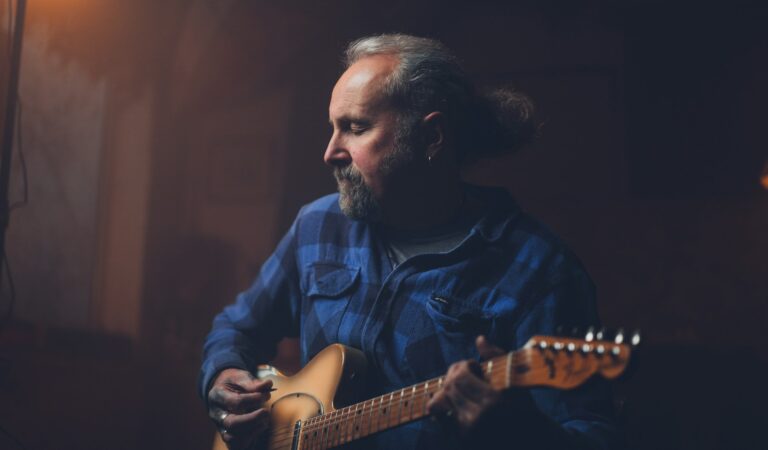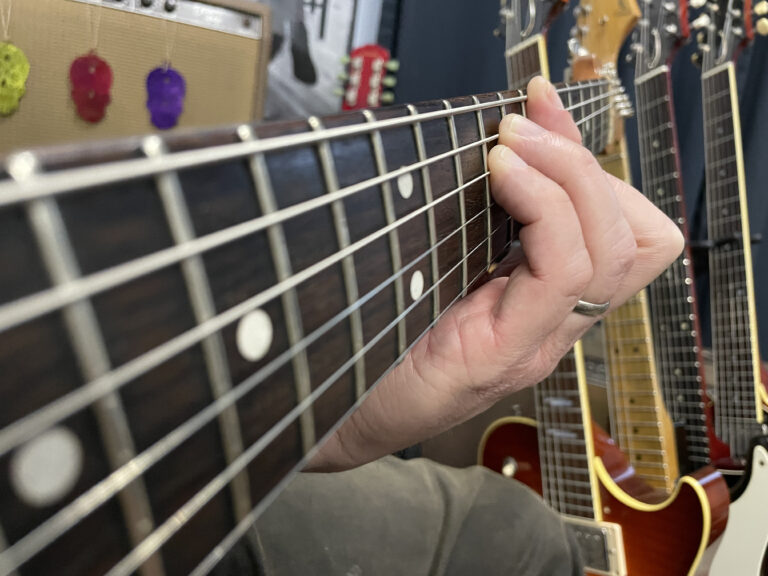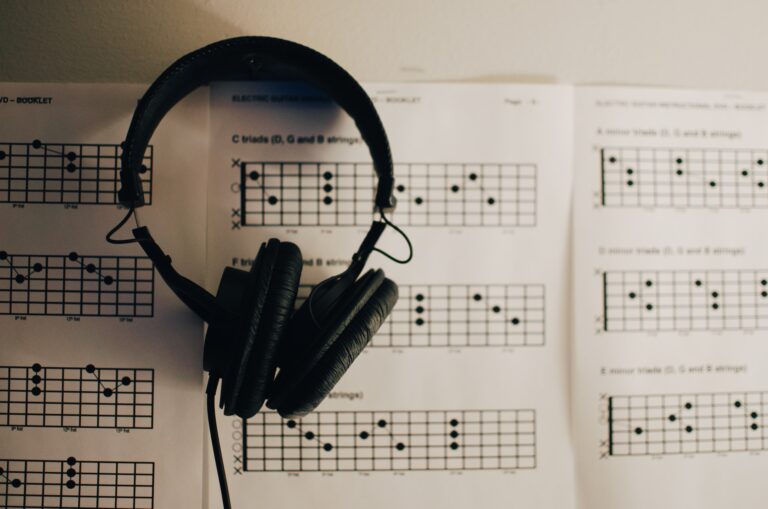You are Wasting Valuable Time on Your Technique
It’s the easiest thing to teach, and it’s the easiest thing for the guitar student to work on.
Blasphemy!
Yeah, I know, I know. Go ahead and get all of the, “But, but, buts…” out of the way. We guitar players love to work on our picking technique and chops—obsessively. It’s a great way to feel like we are doing something really important and sometimes we are. I did it for a long time, too. Many guitar instructors really drill down and spend a lot of time on a student’s picking technique. Why? Because it’s the easiest thing to teach, and it’s the easiest thing for guitar student to work on.
One of the biggest revelations, and revolutions, in my own guitar playing and musicianship happened when I implemented a new approach to my practice routine and gig prep. It was hard, really hard, because I had been approaching it from the standpoint of technique for years. Also because I had been taught that way.
Drilling technique brought me a lot of frustration
When I first moved to Nashville and began working as a guitarist live and in the recording studio, I really had to embrace, question and also solidify a different way of functioning. The Nashville Number System, guitar gear and tones, playing on recording sessions, demos and rehearsals were quite a bit different than I was used to. I was busy. But I had always been busy.
What was the frustration? What was different now? What was I noticing about my playing?
I was performing with multiple artists and bands, rehearsals were fewer in number and time in the recording studio went quite fast. This meant there were a lot of charts to be written, prep time for the one or two rehearsals at most, do the gig and then do it all over again with another artist and another batch of songs.
In the recording studio, we listened to the demo, talked about it for a minute, then pretty much started recording the takes with very little rehearsal. The red record light came on quickly.
It wasn’t uncommon to do all of the electric rhythm and lead parts and the acoustic parts on a whole record in two sessions. Often to keep things moving, I was laying down a second guitar part while the keyboardist was recording a Hammond part after just doing the piano part. Add a tremolo part during the chorus while the background singers were doubling a part, add a 12 string guitar under the solo while the horns added a pad.
It became clear, very quickly and with much anxiety, the way I had been thinking, preparing and working for years was not going to work anymore. Feeling confident about my chops was not enough.
What changed in my practice
This realization was really powerful—shattering and liberating all at once. I had to really consider what kind of guitarist and musician I wanted to be. This cut to the core of how I practiced, prepped and showed up to play. This new information, this new reality allowed me to make significant changes to my own playing and then how I taught my guitar and songwriting students. I know this approach will change the way you think about and approach your time and playing. Warning: it does require unflinching courage and honesty to ponder some things.
I really believe this realization and the changes I made because of it are just as important and beneficial to you. Why? Because I’ve seen it’s benefit for my students and myself. It sounds simple, but it’s not because our brain kicks in and takes over with all kinds of messages and chatter. It comes down to time management and asking yourself what you want you want to do and accomplish. It doesn’t matter if you are playing guitar for and by yourself, jamming with your friends once in a while or wanting to play guitar professionally. You will get more enjoyment and satisfaction out of your time and playing if you focus on more than just technique.
The music I wanted to play began to immediately dictate how I practiced.
For me, it meant the music I wanted to play began to immediately dictate how I practiced. There was a time when I was playing very technically demanding music. I was in college and playing in a band that did all instrumental music. At that time, I worked on my technique alone for hours every day. But the biggest mistake I made was thinking that just working on my technique was going to magically solve my other problems and shortcomings. Even as my musical interests and the musical and scheduling demands changed, I still spent too much time practicing technique at the sacrifice of other important skills that I actually needed to improve. I had been in a routine and habit of approach with my practice that wasn’t serving me anymore. I wasn’t considering my current needs, weaknesses and time constraints.
Now, for myself and for my guitar students, I implement many other important elements into the routine. Keeping your hands and basic chops in shape are one thing. Properly warming up is another. But spending a bulk of your time just doing technical workouts aren’t going to get you where you want to be. If you want to play like B.B. King, you don’t need Yngwie Malmsteem chops. If you only have 30 to 60 minutes a day, three to four times a week to practice, spending half your time doing picking exercises will rob you of time needed for other musical skill development.
A case study: Stevie Ray Vaughn for guitar players
Here’s an example: guitar students will come in and tell me the want to learn some Stevie Ray Vaughn. Regardless of how long the student has been playing, I say, “Great! Let’s do it!” I get excited because I know, like myself, the attraction to those chops, solos and that searing playing and tone is really attractive—and a gateway to more than you’ve bargained for. Learning Stevie’s solos and licks will require an obvious dedication of time to working on your technique, but that is just the beginning.
Steve Ray Vaughan started as a drummer. His rhythm playing is often as challenging as his lead playing, maybe even more so. He was an amazing rhythm guitarist. His phrasing, dynamic control, muting ability and ability to target chord changes are all really important and difficult. Thus, the student gets to begin deeper work on counting, subdividing, swinging and grooving, hand control and some right and left hand palm muting.
Your overall musicianship will greatly improve!
You don’t have to work on your chops relentlessly so one day far down the road you can play a burning Stevie tune. By slowing down the tempo and still being aware of your technique and working on all of the other elements like: phrasing, dynamics, tone, connections to harmony and scales, you gain a better understanding of rhythm and lead guitar. Your overall musicianship will greatly improve!
Stevie could play really hard and aggressively but he also played very quietly and dynamically. This allows us to work on musical phrasing, tone, dynamics, right hand string approach, left hand slurs like pulling off, hammering on and slides. Also, his bends are amazing! That’s a whole other workout on timing and intonation. You see, still technique work, but within the confines of a piece of music, not so separate from. The music is dictating.
Next, you get to look at how he targets chords and uses note selection and timing to get that wonderful tension and release. This opens up work on ear training and understanding when and how he uses major and minor pentatonic scales.
Then there is the amazing tone and how he achieves it. There is a lot of work to be done and a lot of musical benefit to be gained. But if you spend the bulk of time working on picking technique, you will be missing out on many important issues in your playing.
I have had students come in that can play several of his solos but CAN NOT play his rhythm parts, or play the rhythm part to Nowhere Man by the Beatles with the recording without speeding up or missing chord changes. See what I’m getting at here? I tell my guitar students, even the ones that one to be professional players, you will spend a big chunk of time playing rhythm guitar. Unless you want to put your name on a project and do your own thing, you need to be more versatile and well rounded as a player.
Change the way you practice to suit the way you want to play
What do you want to do?
What kind of music do you want to play?
Let the music dictate what you need to work on. Don’t be fooled, or distracted, by chops and technique alone.
The answers are always in the music that inspires you and that you love. Let the music dictate what you need to work on. Don’t be fooled, or distracted, by chops and technique alone. Go ahead, try to play like B.B. King, Grant Green, David Gilmour for a bit. Want to go the other way, Django Reinhardt? Yep, chops are required! But that’s just the beginning of the journey. Don’t overlook all the other stuff!
Happy guitar-ing!
Shane








